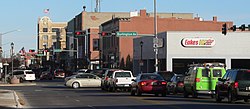Hastings, Nebraska
| Hastings | |
|---|---|
| City | |

Downtown Hastings: 2nd Street, looking eastward
|
|
 Location of Hastings within Adams County and Nebraska |
|
| Coordinates: 40°35′21″N 98°23′30″W / 40.58917°N 98.39167°WCoordinates: 40°35′21″N 98°23′30″W / 40.58917°N 98.39167°W | |
| Country | United States |
| State | Nebraska |
| County | Adams |
| Government | |
| • Mayor | Vern Powers |
| Area | |
| • Total | 13.66 sq mi (35.38 km2) |
| • Land | 13.48 sq mi (34.91 km2) |
| • Water | 0.18 sq mi (0.47 km2) |
| Elevation | 1,926 ft (587 m) |
| Population (2010) | |
| • Total | 24,907 |
| • Estimate (2012) | 25,058 |
| • Density | 1,800/sq mi (700/km2) |
| Time zone | Central (CST) (UTC-6) |
| • Summer (DST) | CDT (UTC-5) |
| ZIP codes | 68901-68902 |
| Area code(s) | 402 |
| FIPS code | 31-21415 |
| GNIS feature ID | 0829848 |
| Website | cityofhastings.org |
Hastings is a city and county seat of Adams County, Nebraska, United States. The population was 24,907 at the 2010 census. It is known as the town where Kool-Aid was invented by Edwin Perkins in 1927, and celebrates that event with the Kool-Aid Days festival every August. Hastings is also known for Fisher Fountain, and during World War II operated the largest Naval Ammunition Depot in the United States.
Hastings was founded in 1872 at the intersection of the Burlington and Missouri River Railroad and the St. Joseph and Denver City Railroad. It was named for Colonel D. T. Hastings of the St. Joseph and Grand Island Railroad, who was instrumental in building the railroad through Adams County. The area was previously open plain: the Donner party passed through on its way to California in 1846 and a pioneer cemetery marker in Hastings bears an inscription taken from Tamsen Donner's journal: "The country between the Blue and the Platte is beautiful beyond compare. Never have I seen so varied a country so suitable to cultivation." In the 1870s, railroads lured European immigrants to the new state of Nebraska with advertisements. Hastings' first settlers were English, from Liverpool, and were quickly joined by other English, Irish, Germans, Danes, and Germans from Russia.
Between 1872 and 1880, when the population had grown to 2,800, Hastings was a boomtown. Settlers first built sod houses, dugouts, and shanties, then houses and stores. The city was incorporated in April 1874, and in September 1878, after a five-year Great County Seat War, the county seat was transferred to Hastings from Juniata. However, a fire in 1879 destroyed 33 buildings downtown. The city was rebuilt between 1880 and 1890 in fireproof materials and in a more planned fashion, with characteristically ornate Victorian buildings, many designed by Charles C. Rittenhouse, the first practicing architect in Adams County and also mayor for ten years. Thanks to the railroads, the city enjoyed great prosperity during the Gilded Age. The population grew to 13,500. This period of expansion ended with the drought and agricultural depression of the 1890s; the town's population fell to 7,000 and would not reach 15,000 until 1930.
...
Wikipedia
